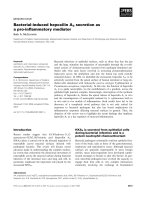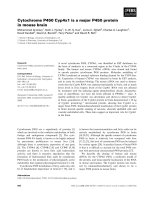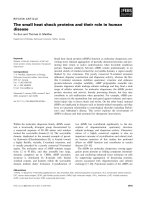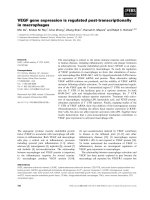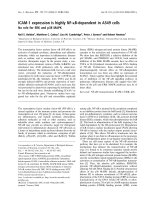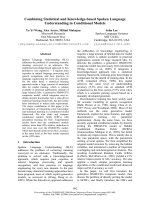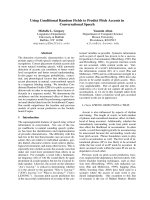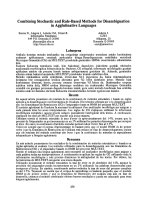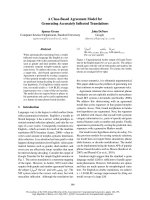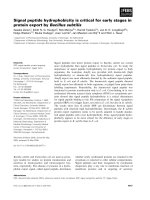báo cáo khoa học: " Adiponectin receptor-1 expression is associated with good prognosis in gastric cancer" pptx
Bạn đang xem bản rút gọn của tài liệu. Xem và tải ngay bản đầy đủ của tài liệu tại đây (737.11 KB, 44 trang )
This Provisional PDF corresponds to the article as it appeared upon acceptance. Fully formatted
PDF and full text (HTML) versions will be made available soon.
Adiponectin receptor-1 expression is associated with good prognosis in gastric
cancer
Journal of Experimental & Clinical Cancer Research 2011, 30:107 doi:10.1186/1756-9966-30-107
Tomoya Tsukada ()
Sachio Fushida ()
Shinichi Harada ()
Shiroh Terai ()
Yasumichi Yagi ()
Jun Kinoshita ()
Katsunobu Oyama ()
Hidehiro Tajima ()
Hideto Fujita ()
Itasu Ninomiya ()
Takashi Fujimura ()
Tetsuo Ohta ()
ISSN 1756-9966
Article type Research
Submission date 14 September 2011
Acceptance date 11 November 2011
Publication date 11 November 2011
Article URL />This peer-reviewed article was published immediately upon acceptance. It can be downloaded,
printed and distributed freely for any purposes (see copyright notice below).
Articles in Journal of Experimental & Clinical Cancer Research are listed in PubMed and archived at
PubMed Central.
For information about publishing your research in Journal of Experimental & Clinical Cancer
Research or any BioMed Central journal, go to
/>Journal of Experimental &
Clinical Cancer Research
© 2011 Tsukada et al. ; licensee BioMed Central Ltd.
This is an open access article distributed under the terms of the Creative Commons Attribution License ( />which permits unrestricted use, distribution, and reproduction in any medium, provided the original work is properly cited.
For information about other BioMed Central publications go to
/>Journal of Experimental &
Clinical Cancer Research
© 2011 Tsukada et al. ; licensee BioMed Central Ltd.
This is an open access article distributed under the terms of the Creative Commons Attribution License ( />which permits unrestricted use, distribution, and reproduction in any medium, provided the original work is properly cited.
pg. 1
Adiponectin receptor
Adiponectin receptorAdiponectin receptor
Adiponectin receptor-
-1
1 1
1 expression
expression expression
expression is associated with
is associated with is associated with
is associated with good
good good
good prognosis in
prognosis in prognosis in
prognosis in
gastric cancer
gastric cancer gastric cancer
gastric cancer
Tomoya Tsukada
1*
, Sachio Fushida
1
, Shinichi Harada
2
, Shiroh Terai
1
,
Yasumichi Yagi
1
, Jun Kinoshita
1
, Katsunobu Oyama
1
, Hidehiro Tajima
1
,
Hideto Fujita
1
, Itasu Ninomiya
1
, Takashi Fujimura
1
, Tetsuo Ohta
1
1
Department of Gastroenterological Surgery, Division of Cancer Medicine,
Graduate School of Medical Science, Kanazawa University, 13-1
Takara-machi, Kanazawa, Ishikawa 920-8641, Japan;
2
Center for
Biomedical Research and Education, School of Medicine, Kanazawa
University, 13-1 Takara-machi, Kanazawa, Ishikawa 920-8641, Japan
*Corresponding author.
Department of Gastroenterological Surgery, Division of Cancer Medicine, Graduate
School of Medical Science, Kanazawa University, 13-1 Takara-machi, Kanazawa,
Ishikawa 920-8641, Japan
Phone: 81-76-265-2362
Fax: 81-76-234-4260
E-mail:
E-mail addresses
SF:
SH:
ST:
YY:
JK:
KO:
HT:
HF:
IN:
TF:
TO:
pg. 2
Abstract
AbstractAbstract
Abstract
Background:
Background:Background:
Background: Adiponectin is inversely related to BMI, positively correlates
with insulin sensitivity, and has anti-atherogenic effects. In recent years,
adiponectin has been well studied in the field of oncology. Adiponectin has
been shown to have antiproliferative effects on gastric cancer, and
adiponectin expression is inversely correlated with clinical staging of the
disease. However, no studies have reported the correlation between serum
adiponectin and receptor expression with disease progression.
Methods:
Methods:Methods:
Methods: In this study, we evaluated expression levels of 2 adiponectin
receptors—AdipoR1 and AdipoR2—and attempted to correlate their
expression with prognosis in gastric cancer patients. AdipoR1 and AdipoR2
expression in gastric cancer cell lines (MKN45, TMK-1, NUGC3, and
NUGC4) was evaluated by western blotting analysis, and the
antiproliferative potential of adiponectin was examined in vitro. Serum
adiponectin levels were evaluated in 100 gastric cancer patients, and the
expression of AdipoR1 and AdipoR2 was assessed by immunohistochemical
staining.
Results:
Results:Results:
Results: MKN45 and NUGC3 expressed higher levels of AdipoR1 compared
to NUGC4, even though there was no significance in AdipoR2 expression.
The antiproliferative effect of adiponectin was confirmed in MKN45 and
NUGC3 at 10 µg/ml. No significant associations were observed between
serum adiponectin levels and clinicopathological characteristics, but
lymphatic metastasis and peritoneal dissemination were significantly higher
pg. 3
in the negative AdipoR1 immunostaining group (24/32,
p
= 0.013 and 9/32,
p
= 0.042, respectively) compared to the positive AdipoR1 group (lymphatic
metastasis, 33/68; peritoneal dissemination, 8/68). On the other hand,
AdipoR2 expression was only associated with histopathological type (
p
=
0.001). In survival analysis, the AdipoR1 positive staining group had
significantly longer survival rates than the negative staining group (
p
= 0.01).
However, multivariate analysis indicated that AdipoR1 was not an
independent prognostic factor on patient’s survival on gastric cancer.
Conclusions:
Conclusions: Conclusions:
Conclusions: In gastric cancer, adiponectin has the possibility to be involved
in cell growth suppression via AdipoR1. The presence of AdipoR1 could be a
novel anticancer therapeutic target in gastric cancer.
Keywords
KeywordsKeywords
Keywords:
Adiponectin, AdipoR1, AdipoR2, gastric cancer, survival
pg. 4
Background
BackgroundBackground
Background
As the number of obese patients increases, there is growing interest in
cytokines secreted by adipocytes. Human adiponectin (also known as
Acrp30
[1] or
AdipoQ
[2]) is a 25-kDa adipocytokine composed of 247 amino acids;
adiponectin is highly and specifically expressed in differentiated adipocytes
and circulates at a concentration of 5-10µg/ml in the blood stream [1-5].
Serum adiponectin levels correlate with insulin sensitivity and lipid
metabolism [6,7]. Many studies have reported that adiponectin is related to
obesity [8], metabolic syndrome [9,10], type 2 diabetes mellitus [11-13], and
arteriosclerosis [14,15]. In addition, weight reduction increases adiponectin
levels in obese patients [16]. Recent studies have shown that decreased
plasma adiponectin levels significantly correlate with the risk of various
cancers such as esophageal [17], colorectal [18], breast [19], endometrial [20],
prostate [21], renal cell [22], and gastric cancer [23]. However, the role of
adiponectin in cancer etiology is not yet fully understood. Although
adiponectin may provide indirect protection against carcinogenesis by
affecting insulin sensitivity and inflammatory states, it has direct
anti-carcinogenic effects through the AMP-activated protein kinase (AMPK)
system. Activated AMPK plays an important role in the regulation of growth
arrest and apoptosis by stimulating p53 and p21 [24]. Moreover, independent
of AMPK activation, adiponectin decreases production of reactive oxygen
species (ROS) [25], which may result in decreased activation of
mitogen-activated-protein-kinase (MAPK) [26] and subsequently results in
pg. 5
inhibition of cell proliferation.
The adiponectin receptor exists in 2 isoforms: adiponectin receptor 1
(AdipoR1), which is abundantly expressed in skeletal muscle, and
adiponectin receptor 2 (AdipoR2), which is predominantly expressed in
skeletal muscle and the liver [27]. The expression of these receptors has been
reported in gastric cancer cell lines, and adiponectin has been shown to
inhibit proliferation and peritoneal dissemination through AdipoR1/R2
activation on gastric cancer cells [28]. However, the correlation between
AdipoR1 or AdipoR2 expression and overall survival rate, and the clinical
importance of these receptors remain unclear. In this study, we analyzed the
correlation between serum adiponectin levels, expression of AdipoR1/R2, and
clinicopathological characteristics as well as overall patient survival in
gastric cancer.
M
MM
Methods
ethodsethods
ethods
Reagents and cell lines
Reagents and cell linesReagents and cell lines
Reagents and cell lines
Recombinant human adiponectin was purchased from R&D Systems,
(Minneapolis, MN, USA), reconstituted in phosphate-buffered saline (PBS)
at appropriate concentrations and stored at 4°C until use.
Human gastric cancer cell lines, TMK-1 (poorly differentiated
adenocarcinoma) and MKN45 (poorly differentiated adenocarcinoma) were
obtained from the American Type Culture Collection (Rockville, MD, USA),
pg. 6
NUGC3 (poorly differentiated adenocarcinoma) and NUGC4 (signet ring cell
carcinoma) were obtained from the Japanese Collection of Research
Bioresources (National Institute of Health Sciences, Tokyo, Japan). The
culture medium for cells was RPMI 1640 (Gibco, Invitrogen, Tokyo, Japan)
supplemented with 10% heat-inactivated fetal bovine serum (Nichirei
Bioscience Inc., Tokyo, Japan), 100 IU/ml penicillin, 100 mg/ml streptomycin
(Gibco), and 2 mM glutamine (Nissui Pharmaceutical Co., Ltd., Tokyo,
Japan). Cell lines were seeded in 75-cm
2
dish flasks (Becton Dickinson,
Tokyo, Japan) and cultured in 10 mL of medium at 37°C in a humidified
atmosphere of 5% CO
2
in air. Cells were grown to confluence and harvested
by trypsinization with 0.25% trypsin/EDTA (Gibco) and suspended in culture
medium before use.
Western blotting
Western blottingWestern blotting
Western blotting
Immunoblot analysis was performed as described previously [29].
Cells were lysed in RIPA buffer (50 mmol/l pH 8.0 Tris-HCl, 150 mmol/l
sodium chloride, 0.5 w/v% sodium deoxycholate, 0.1 w/v% sodium dodecyl
sulfate, and 1.0 w/v% NP-40 substitute) (Wako, Tokyo, Japan) containing 1%
protease inhibitor cocktail (Sigma-Aldrich, St. Louis, MO, USA). The protein
concentration of each sample was measured using a BCA protein assay kit
(Pierce Biotechnology, Rockford, IL, USA). Whole-cell lysates were prepared
in denaturing SDS sample buffer and subjected to SDS-PAGE (ATTO Co.
Ltd., Tokyo, Japan). Proteins were transferred to PVDF membranes
pg. 7
(Bio-Rad Laboratories, Hercules, CA, USA) and then blocked with
commercial gradient buffer (EzBlock; Atto Corporation, Tokyo, Japan) at
room temperature for 30 min. The immunoblots were visualized using an
ECL Plus kit (GE Healthcare UK Ltd., Tokyo, Japan). The antibody-antigen
complex was detected using an ECL Western-Blotting detection kit (GE
Healthcare) and the Light-Capture system (ATTO), and then quantified
using the CS analyzer program (ATTO). All experiments were repeated three
times. We used the following primary antibodies: anti-AdipoR1 antibody
(C-14, goat polyclonal IgG, diluted 1:100; Santa Cruz Biotechnology Inc.,
Santa Cruz, CA, USA), anti-AdipoR2 (C-12, goat polyclonal IgG, diluted
1:100; Santa Cruz), and anti-β-actin (AC-15, mouse monoclonal IgG, diluted
1:10,000; Sigma-Aldrich).
Cell growth assay
Cell growth assayCell growth assay
Cell growth assay
The viability of gastric cancer cell lines treated with adiponectin was
determined by standard 3-(4, 5-dimethylthiazol-2-yl)-2,
5-diphenyltetrazolium bromide (MTT) assay. Cell were seeded at 5 × 10
3
cells
per well in 96-well plates and incubated overnight at 37°C. After incubation,
the supernatant was discarded and replaced with fresh serum-free culture
medium. Adiponectin was dissolved in PBS and added to the cell culture
medium at various concentrations (0, 0.1, 1, 5, or 10 µg/ml). At 48 h after
exposure to adiponectin, the supernatant was discarded, and MTT solution
was added to each well (500 µg/mL, final concentrations) and incubated at
pg. 8
37°C for 3 h. The supernatant was removed, and 150 µL of dimethylsulfoxide
(DMSO: Wako, Japan) was added. The absorbance of the solution was read at
a wavelength of 540 nm using a microplate reader (BIO-RAD550; BIO-RAD,
Tokyo, Japan). The percentage inhibition was determined by comparing the
cell density of the drug-treated cells with that of untreated controls. All
experiments were repeated at least 3 times.
Specimens and blood samples
Specimens and blood samplesSpecimens and blood samples
Specimens and blood samples
We evaluated 100 patients with gastric cancer (cases) who were
treated with curative gastrectomy and standard lymph node dissection at the
Gastroenterological Surgery Department, Kanazawa University Hospital,
Ishikawa, from 2002 to 2009. The study was approved by the ethics
committee of Kanazawa University, and informed consent was obtained from
each patient before enrollment in this study. All resected primary tumors
and regional lymph nodes were histologically evaluated by H&E staining
according to the Japanese Classification of Gastric Carcinoma [30]. A fasting
morning blood sample was obtained for the adiponectin assay from each
patient after admission into the study. Samples were also obtained from 10
healthy volunteer controls. Weight and height of each patient was recorded
by medical staff. BMI was calculated as weight in kilograms divided by
height in square meters. Medical staff measured all data.
S
SS
Serum adiponectin measurement
erum adiponectin measurementerum adiponectin measurement
erum adiponectin measurement
pg. 9
All blood samples were immediately separated by centrifugation and
stored at ―80°C until use. A quantitative sandwich enzyme-linked
immunosorbent assay technique with a Quantikine human adiponectin
immunoassay kit (R&D Systems, Inc., Minneapolis, NM, USA) was used in
accordance with the manufacturer’s instructions. All experiments were
performed in triplicate.
Immunohistochemical staining
Immunohistochemical stainingImmunohistochemical staining
Immunohistochemical staining
All surgically obtained specimens were fixed in 10% neutral buffered
formalin, embedded in paraffin, and cut into 4-µm-thick serial sections. In
brief, the slides were immersed in methanol containing 0.3% H
2
O
2
for 30 min,
blocked with 3.3% normal goat serum in PBS, and incubated with the
anti-AdipoR1 antibody (C-14, goat polyclonal IgG, diluted 1:100; Santa Cruz
Biotechnology Inc., Santa Cruz, CA, USA) and anti-AdipoR2 (C-12, goat
polyclonal IgG, diluted 1:100; Santa Cruz) at 4°C overnight. After the
sections were washed in PBS, immunoreactivity was visualized by EnVision
reagent (Dako Co., Kyoto, Japan). Slides were examined under low power
(×40) to identify the brown staining precipitates within the cytoplasm of
cancer cells. Sections that showed same or higher staining than that of the
normal gastric mucosa and more than 10% of cancerous tissue stained under
a ×100 field were considered positive samples.
Statistica
StatisticaStatistica
Statistical analysis
l analysisl analysis
l analysis
pg. 10
Values are expressed as means ± standard error (SE). Differences in
the cell growth assay were determined by one-way analysis of variance
(ANOVA). The relationship between serum adiponectin level and BMI or
clinical stage of gastric cancer was evaluated using the Mann-Whitney U test.
Fisher exact and χ
2
test were used to evaluate statistical correlations
between plasma adiponectin levels, the expression of AdipoR1 or AdipoR2 in
cancerous tissues, and various clinicopathological variables. Overall survival
rates were estimated using the Kaplan–Meier method, and a log-rank test
was used to compare results between survival time and AdipoR1 or AdipoR2
immunohistochemical expression. The influence of various
clinicopathological factors, including AdipoRs expression, on survival was
assessed by the Cox proportional hazards model (multivariate analysis)
using backward-LR methods. All statistical analyses were performed using
the computer software package SPSS 10.0 (SPSS Inc., Chicago, IL, USA).
Significance was defined as
p
< 0.05.
Results
ResultsResults
Results
Expression of AdipoR1/R2 and effect of adiponectin on gastric cancer cells
Expression of AdipoR1/R2 and effect of adiponectin on gastric cancer cells Expression of AdipoR1/R2 and effect of adiponectin on gastric cancer cells
Expression of AdipoR1/R2 and effect of adiponectin on gastric cancer cells
To determine the expression of AdipoR1/R2 in gastric cancer cell lines,
western blotting analysis was performed. As shown in figure 1A, AdipoR1/R2
were positively detected in cell lines, and compared with NUGC4, MKN45
and NUGC3 had higher expression of AdipoR1. On the other hand, no
significant differences were observed in expression of AdipoR2 (Fig. 1B).
pg. 11
In MKN45 and NUGC3, adiponectin significantly suppressed
proliferation at 10 µg/ml (78.5% ± 3.3%, 54.9% ± 37.5%, respectively,
p
< 0.05).
In contrast, NUGC4 and TMK-1 were slightly suppressed after 48 h
exposure of adiponectin, but the effect was not significant even at a
concentration of 10 µg/ml (Fig. 2).
Serum adiponectin and clinicopathological characteristics
Serum adiponectin and clinicopathological characteristicsSerum adiponectin and clinicopathological characteristics
Serum adiponectin and clinicopathological characteristics
As shown in figure 3, no significant differences were observed between
serum adiponectin and BMI in gastric cancer patients. However, adiponectin
concentrations showed a tendency to decrease gradually with an increase in
BMI (Fig. 3A). Compared with the control group, no significant differences in
adiponectin were observed between tumor stages (Fig. 3B).
The mean value of serum adiponectin in the control group was 7.0 ±
2.4 µg/ml. Therefore, we divided the patients into low (n = 39) and high (n =
61) groups using a cutoff value of 7.0, and clinicopathological characteristics
were compared between the 2 groups (Table 1). No significant differences
were observed in age, BMI, macroscopic tumor type, depth of tumor invasion,
histopathological type, lymphatic invasion, venous invasion, lymphatic
metastasis, peritoneal dissemination, hematogenous metastasis, or tumor
stages between the 2 groups. Forty-six (69.7%) of 66 male patients were
categorized in the low group, whereas only 15 (44.1%) of 34 female patients
were categorized in this group.
pg. 12
AdipoR1/R2 expression in gastric cancer
AdipoR1/R2 expression in gastric cancerAdipoR1/R2 expression in gastric cancer
AdipoR1/R2 expression in gastric cancer
The protein expression of AdipoR1 and AdipoR2 was confirmed by
immunostaining of surgically resected gastric cancer tissue specimens (Fig.
4). AdipoR1 and AdipoR2 were positively detected in the cytoplasm as well as
the cell membrane of cancer cells. In contrast, normal gastric epithelial cells
did not show significant immunoreactivity for either AdipoR1 or AdipoR2. In
some parietal cells of normal gastric mucosa, slight reactivity was observed
in AdipoR2 expression. This was in accordance with the findings of Ishikawa
et al [28].
AdipoR1 expression was significantly associated with
histopathological type (
p
= 0.011) (Table 2). In addition, negative AdipoR1
immunostaining was significantly higher in patients with lymphatic
metastasis (
p
= 0.013; Table 2) and peritoneal dissemination (
p
= 0.042;
Table 2). On the other hand, AdipoR2 expression was also associated with
the histopathological type (
p
= 0.001; Table 3). However, no significant
differences were observed in other clinicopathological characteristics (Table
3).
Survival
SurvivalSurvival
Survival analysis
analysis analysis
analysis
Survival rates according to serum adiponectin levels, the presence or
absence of AdipoR1 expression, and AdipoR2 expression were assessed using
the Kaplan-Meier method. There were no significant differences in survival
rate between the groups with high and low serum adiponectin levels (
p
=
pg. 13
0.8342; Fig. 5).
Patients with positive AdipoR1 staining had a significantly longer
survival rate than those with negative staining (
p
= 0.01; Fig. 6), whereas
there were no significant differences in AdipoR2 expression between these 2
groups (
p
= 0.9871; Fig. 7).
Multivariate analysis indicated that only the peritoneal dissemination
was an independent prognostic factor on patient’s survival (
p
= 0.001; Table
4).
Discussion
DiscussionDiscussion
Discussion
Adiponectin, which belongs to the complement 1q family, is composed
of an N-terminal collagen-like sequence and a C-terminal globular region, is
well studied in the field of oncology, and its expression is inversely related to
weight gain [31]. Ishikawa et al. reported that a low serum adiponectin level
was associated with an increased risk of gastric cancer, although BMI did not
differ significantly [23]. In our study, we were also unable to detected
significant differences with respect to serum adiponectin levels and BMI.
However, visceral fat predominantly correlates with serum adiponectin
levels [32], and BMI cannot be used to distinguish fat distribution (for
example, subcutaneous fat versus visceral fat); this may be the reason for the
failure to find a significant correlation between the 2 parameters. In addition,
a correlation was not observed between the amounts of serum adiponectin
and clinicopathological factors or prognosis in gastric cancer. Ishikawa et al.
pg. 14
indicated a tendency of an inverse correlation between tumor stage and
serum adiponectin levels, but significant difference was not demonstrated in
the current study. With respect to clinicopathological factors, there were
significant differences in adiponectin levels according to tumor location and
differentiation [23]. Seker et al. also reported significant difference between
degrees of tumor differentiations and adiponectin levels [33]. Gastric cancer
patients tend to be cachexic with the progression of primary disease, and this
can result in high serum adiponectin levels [34]. Consequently, it is difficult
to elucidate the clinicopathological significance of adiponectin in
gastroenterological cancer patients because of the aforementioned
contradictory relationship [35]. As a result of this lack of significant
difference between the clinicopathological factors and serum adiponectin
levels, it is presumed that serum adiponectin levels do not contribute to
prolonged survival in gastric cancer patients.
Generally, it is expected that receptor expression is more important
than the amount of serum ligand, but no studies have addressed serum
adiponectin and receptor expression levels.
Moreover, the expression of adiponectin receptors in gastric cancer cell
lines has already been reported [28]. They also demonstrated that the
inhibitory effects of adiponectin via AdipoR1 and AdipoR2 using specifically
down-regulated experiments by siRNA. In their study, siRNA of adipoR1
strongly abolished the effects of adiponectin, although the effect of siRNA of
adipoR2 was less prominent. In our examination, adiponectin led to growth
pg. 15
inhibition in MKN45 and NUGC3. The two cell lines expressed AdipoR1
strongly, even though there were no significance in AdipoR2 expression.
Therefore, it is likely that AdipoR1 plays an important role in cell
proliferation. Although AdipoR1 and R2 are known as receptor subtypes, the
relationship between gastric cancer and each subtype has not yet been
clarified. Therefore, we evaluated the association between AdipoR expression
and clinicopathological characteristics. The expression rates of both
receptors were lower in histopathologically undifferentiated tumor types.
However, the significant findings in our series indicate that the AdipoR1
expression-positive group showed lower lymphatic metastasis and peritoneal
dissemination than the negative group. On the other hand, no clear
associations were observed between AdipoR2 expression and any of the
clinical characteristics that we evaluated. Otani et al. [36] reported that
there are no significant associations between AdipoR1 mRNA levels and
various pathological features in gastric cancer, whereas Barresi et al.
reported longer overall survival in patients with positive AdipoR1/R2
expression [37]. Our clinical results reconfirm that AdipoR1 expression
inversely correlates with tumor growth and might contributes to
improvement of prognosis significantly, but not independently, in gastric
cancer patients. However, expression of AdipoR2 does not affect prognosis,
and there was no correlation between clinicopathological factors and
AdipoR2 expression.
Adiponectin can exist as a full-length or a smaller, globular fragment.
pg. 16
It has been proposed that the globular fragment is generated by proteolytic
cleavage, and it has recently been shown that the cleavage of adiponectin by
leukocyte elastase secreted from activated monocytes and/or neutrophils
could be responsible for the generation of the globular adiponectin fragment
[38]. On the other hand, AdipoR1 and AdipoR2 may form both homo- and
heteromultimers. Scatchard plot analysis revealed that AdipoR1 is a
receptor for globular adiponectin, whereas AdipoR2 is a receptor for the
full-length form of adiponectin [39]. The ability of adiponectin to inhibit
caspase-3 mediated cell death has been reported in various cells, including
endothelial, neuroblastoma, and pancreatic β cells [40,41,42]. Park’s group
[43] demonstrated that globular adiponectin acting via AdipoR1 could
protect mouse cardiomyocytes from apoptosis. Here, we show a cytostatic
effect of adiponectin via AdipoR1, but the repression of cell proliferation via
both AdipoR1- and AdipoR2-mediated AMPK has been also reported [44].
The improvement of prognosis in gastric cancer patients with positive
AdipoR1 expression might be affected by organ protective effects from
insulin resistance and inflammatory states rather than as a result of a direct
antiproliferative effect via globular adiponectin.
Conclusion
ConclusionConclusion
Conclusions
ss
s
Our data suggest that adiponectin has antiproliferative potential;
however, AdipoR1 plays a more important role in increased survival in
pg. 17
gastric cancer patients. The mechanisms underlying the anti-tumor effects of
adiponectin and the functional properties of AdipoR have not been fully
elucidated. Although further research in this field is necessary, the presence
of AdipoR1 could be a novel anticancer therapeutic target in gastric cancer.
pg. 18
Author contributions
Author contributionsAuthor contributions
Author contributions
TT carried out most of experiments, participated in the design of the
study, performed the statistical analysis, and drafted the manuscript. SF, SH,
ST, and YY participated in the design of the study and helped draft the
manuscript. JK, KO, HT, and HF assisted the experiments. IN, TF, and TO
participated in the study design and coordination. All authors have read and
approved the final manuscript.
Competing interests
Competing interestsCompeting interests
Competing interests
The authors declare that they have no competing interests.
pg. 19
References
ReferencesReferences
References
[1] Scherer PE, Williams S, Fogliano M, Baldini G, Lodish HF. A novel serum
protein similar to C1q, produced exclusively in adipocytes. J Biol Chem 1995,
270:26746-26749.
[2] Hu E, Liang P, Spiegelman BM. AdipoQ is a novel adipose-specific gene
dysregulated in obesity. J Biol Chem 1996, 271:10697-10703.
[3] Chandran M, Phillips SA, Ciaraldi T, Henry RR: Adiponectin: more than
just another fat cell hormone? Diab Care 2003, 26:2442-2450.
[4] Maeda K, Okubo K, Shimomura I, Funahashi T, Matsuzawa Y,
Matsubara K: cDNA cloning and expression of a novel adipose specific
collagen-like factor, apM1 (AdiPose Most abundant Gene transcript 1).
Biochem Biophys Res Commun 1996, 221:286-289.
[5] Nakano Y, Tobe T, Choi-Miura NH, Mazda T, Tomita M: Isolation and
characterization of GBP28, a novel gelatin-binding protein purified from
human plasma. J Biochem 1996, 120:803-812.
[6] Yamauchi T, Kamon J, Waki H, Terauchi Y, Kubota N, Hara K, Mori Y, Ide
T, Murakami K, Tsuboyama-Kasaoka N, Ezaki O, Akanuma Y, Gavrilova O,
Vinson C, Reitman ML, Kagechika H, Shudo K, Yoda M, Nakano Y, Tobe K,
Nagai R, Kimura S, Tomita M, Froguel P, Kadowaki T. The fat-derived
hormone adiponectin reverses insulin resistance associated with both
lipoatrophy and obesity. Nat Med 2001, 7:941-946.
[7] Berg AH, Combs TP, Du X, Brownlee M, Scherer PE. The adipocyte
secreted protein Acrp30 enhances hepatic insulin action. Nat Med 2001,
pg. 20
7:947-953.
[8] Arita Y, Kihara S, Ouchi N, Takahashi M, Maeda K, Miyagawa J, Hotta K,
Shimomura I, Nakamura T, Miyaoka K, Kuriyama H, Nishida M, Yamashita
S, Okubo K, Matsubara K, Muraguchi M, Ohmoto Y, Funahashi T,
Matsuzawa Y. Paradoxical decrease of an adipose-specific protein,
adiponectin, in obesity. Biochem Biophys Res Commun 1999, 257:79-83.
[9] Hara K, Horikoshi M, Yamauchi T, Yago H, Miyazaki O, Ebinuma H, Imai
Y, Nagai R, Kadowaki T. Measurement of the high-molecular weight form of
adiponectin in plasma is useful for the prediction of insulin resistance and
metabolic syndrome. Diabetes Care 2006, 29:1357-1362.
[10] Ryo M, Nakamura T, Kihara S, Kumada M, Shibazaki S, Takahashi M,
Nagai M, Matsuzawa Y, Funahashi T. Adiponectin as a biomarker of the
metabolic syndrome. Circ J 2004, 68:975-981.
[11] Daimon M, Oizumi T, Saitoh T, Kameda W, Hirata A, Yamaguchi H,
Ohnuma H, Igarashi M, Tominaga M, Kato T. Decreased serum levels of
adiponectin are a risk factor for the progression to type 2 diabetes in the
Japanese population: the Funagata study. Diabetes Care 2003,
26:2015-2020.
[12] Spranger J, Kroke A, Möhlig M, Bergmann MM, Ristow M, Boeing H,
Pfeiffer AF. Adiponectin and protection against type 2 diabetes mellitus.
Lancet 2003, 361:226-228.
[13] Weyer C, Funahashi T, Tanaka S, Hotta K, Mtsuzawa Y, Pratley RE,
Tataranni PA. Hypoadiponectinemia in obesity and type 2 diabetes: close
pg. 21
association with insulin resistance and hyperinsulinemia. J Clin Endocrinol
Metab 2001, 86:1930-1935.
[14] Matsuda M, Shimomura I, Sata M, Arita Y, Nishida M, Maeda N,
Kumada M, Okamoto Y, Nagaretani H, Nishizawa H, Kishida K, Komuro R,
Ouchi N, Kihara S, Nagai R, Funahashi T, Matsuzawa Y. Role of adiponectin
in preventing vascular stenosis: the missing link of adipo-vascular axis. J
Biol Chem 2002, 277:37487-37491.
[15] Ouchi N, Kihara S, Arita Y, Nishida M, Matsuyama A, Okamoto Y,
Ishigami M, Kuriyama H, Kishida K, Nishizawa H, Hotta K, Muraguchi M,
Ohmoto Y, Yamashita S, Funahashi T, Matsuzawa Y. Adipocyte-derived
plasma protein, adiponectin, suppresses lipid accumulation and class A
scavenger receptor expression in human monocyte-derived macrophages.
Circulation 2001, 103:1057-1063.
[16] Hotta K, Funahashi T, Arita Y, Takahashi M, Matsuda M, Okamoto Y,
Iwahashi H, Kuriyama H, Ouchi N, Maeda K, Nishida M, Kihara S, Sakai N,
Nakajima T, Hasegawa K, Muraguchi M, Ohmoto Y, Nakamura T, Yamashita
S, Hanafusa T, Matsuzawa Y. Plasma concentrations of a novel,
adipose-specific protein, adiponectin, in type 2 diabetic patients. Arterioscler
Thromb Vasc Biol 2000, 20:1595-1599.
[17]. Ogunwobi OO, Beales IL. Globular adiponectin, acting via adiponectin
receptor-1, inhibits leptin-stimulated oesophageal adenocarcinoma cell
proliferation. Mol Cell Endocrinol 2008, 285:43-50.
[18]. Wei EK, Giovannucci E, Fuchs CS, Willett WC, Mantzoros CS. Low
pg. 22
plasma adiponectin levels and risk of colorectal cancer in men: a prospective
study. J Natl Cancer Inst 2005, 97:1688-1694.
[19]. Miyoshi Y, Funahashi T, Kihara S, Taguchi T, Tamaki Y, Matsuzawa Y,
Noguchi S. Association of serum adiponectin levels with breast cancer risk.
Clin Cancer Res 2003, 9:5699-5704.
[20]. Soliman PT, Wu D, Tortolero-Luna G, Schmeler KM, Slomovitz BM,
Bray MS, Gershenson DM, Lu KH. Association between adiponectin, insulin
resistance, and endometrial cancer. Cancer 2006, 106:2376-2381.
[21]. Goktas S, Yilmaz MI, Caglar K, Sonmez A, Kilic S, Bedir S. Prostate
cancer and adiponectin. Urology 2005, 65:1168-1172.
[22]. Spyridopoulos TN, Petridou ET, Skalkidou A, Dessypris N, Chrousos GP,
Mantzoros CS; Obesity and Cancer Oncology Group. Low adiponectin levels
are associated with renal cell carcinoma: a case-control study. Int J Cancer
2007, 120:1573-1578.
[23]. Ishikawa M, Kitayama J, Kazama S, Hiramatsu T, Hatano K, Nagawa
H. Plasma adiponectin and gastric cancer. Clin Cancer Res 2005, 11:466-472.
[24]. Igata M, Motoshima H, Tsuruzoe K, Kojima K, Matsumura T, Kondo T,
Taguchi T, Nakamaru K, Yano M, Kukidome D, Matsumoto K, Toyonaga T,
Asano T, Nishikawa T, Araki E. Adenosine monophosphate-activated protein
kinase suppresses vascular smooth muscle cell proliferation through the
inhibition of cell cycle progression. Circ Res 2005, 97:837-844.
[25]. Ouedraogo R, Wu X, Xu SQ, Fuchsel L, Motoshima H, Mahadev K,
Hough K, Scalia R, Goldstein BJ. Adiponectin suppression of
pg. 23
high-glucose-induced reactive oxygen species in vascular endothelial cells:
evidence for involvement of a cAMP signaling pathway. Diabetes 2006,
55:1840-1846.
[26]. Govindarajan B, Klafter R, Miller MS, Mansur C, Mizesko M, Bai X,
LaMontagne K Jr, Arbiser JL. Reactive oxygen-induced carcinogenesis
causes hypermethylation of p16(Ink4a) and activation of MAP kinase. Mol
Med 2002, 8:1-8.
[27] Yamauchi T, Kamon J, Ito Y, Tsuchida A, Yokomizo T, Kita S, Sugiyama
T, Miyagishi M, Hara K, Tsunoda M, Murakami K, Ohteki T, Uchida S,
Takekawa S, Waki H, Tsuno NH, Shibata Y, Terauchi Y, Froguel P, Tobe K,
Koyasu S, Taira K, Kitamura T, Shimizu T, Nagai R, Kadowaki T: Cloning of
adiponectin receptors that mediate antidiabetic metabolic effects. Nature
2003, 423:762-769.
[28]. Ishikawa M, Kitayama J, Yamauchi T, Kadowaki T, Maki T, Miyato H,
Yamashita H, Nagawa H. Adiponectin inhibits the growth and peritoneal
metastasis of gastric cancer through its specific membrane receptors
AdipoR1 and AdipoR2. Cancer Sci 2007, 98:1120-1127.
[29]. Yagi Y, Fushida S, Harada S, Kinoshita J, Makino I, Oyama K, Tajima
H, Fujita H, Takamura H, Ninomiya I, Fujimura T, Ohta T, Yashiro M,
Hirakawa K. Effects of valproic acid on the cell cycle and apoptosis through
acetylation of histone and tubulin in a scirrhous gastric cancer cell line. J
Exp Clin Cancer Res 2010, 29:149.
[30]. Japanese Gastric Cancer Association. Japanese classification of gastric
